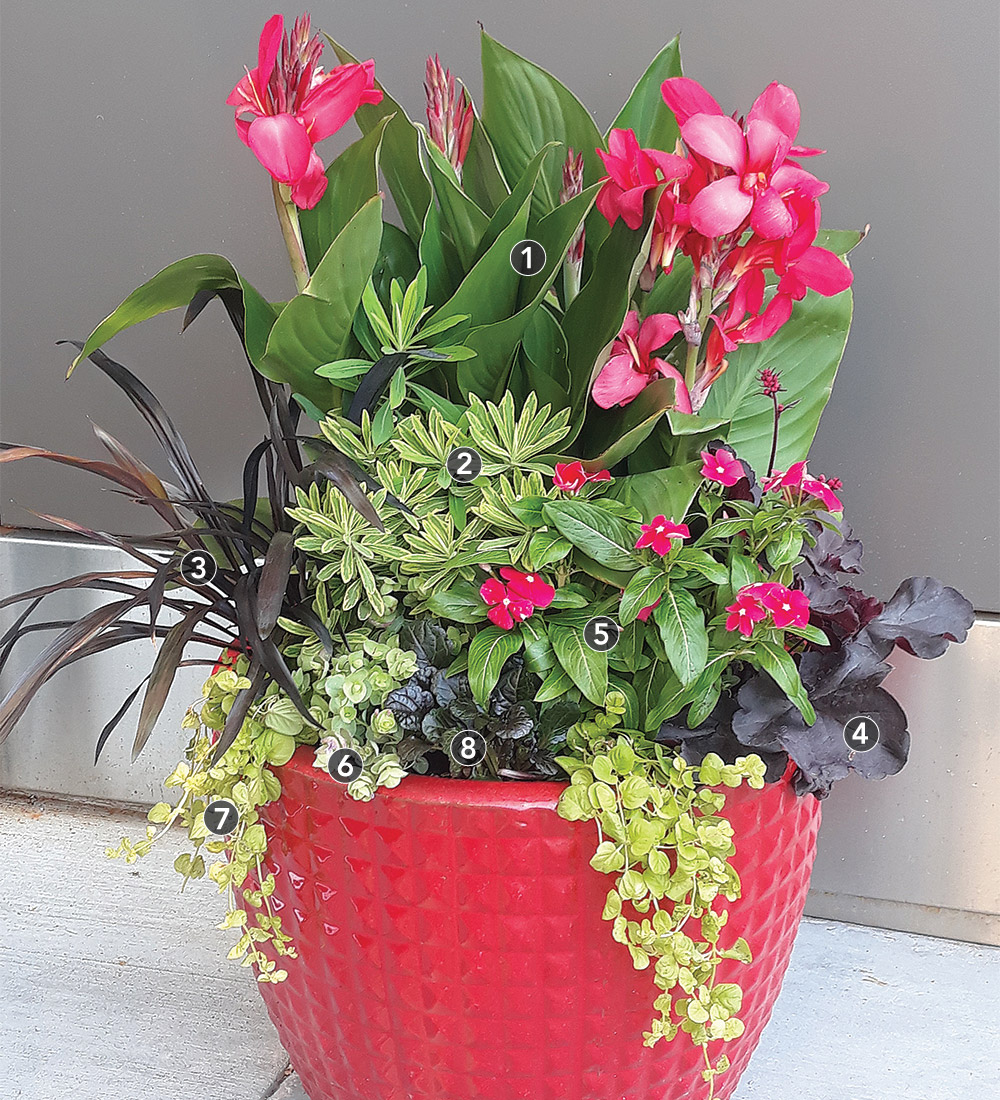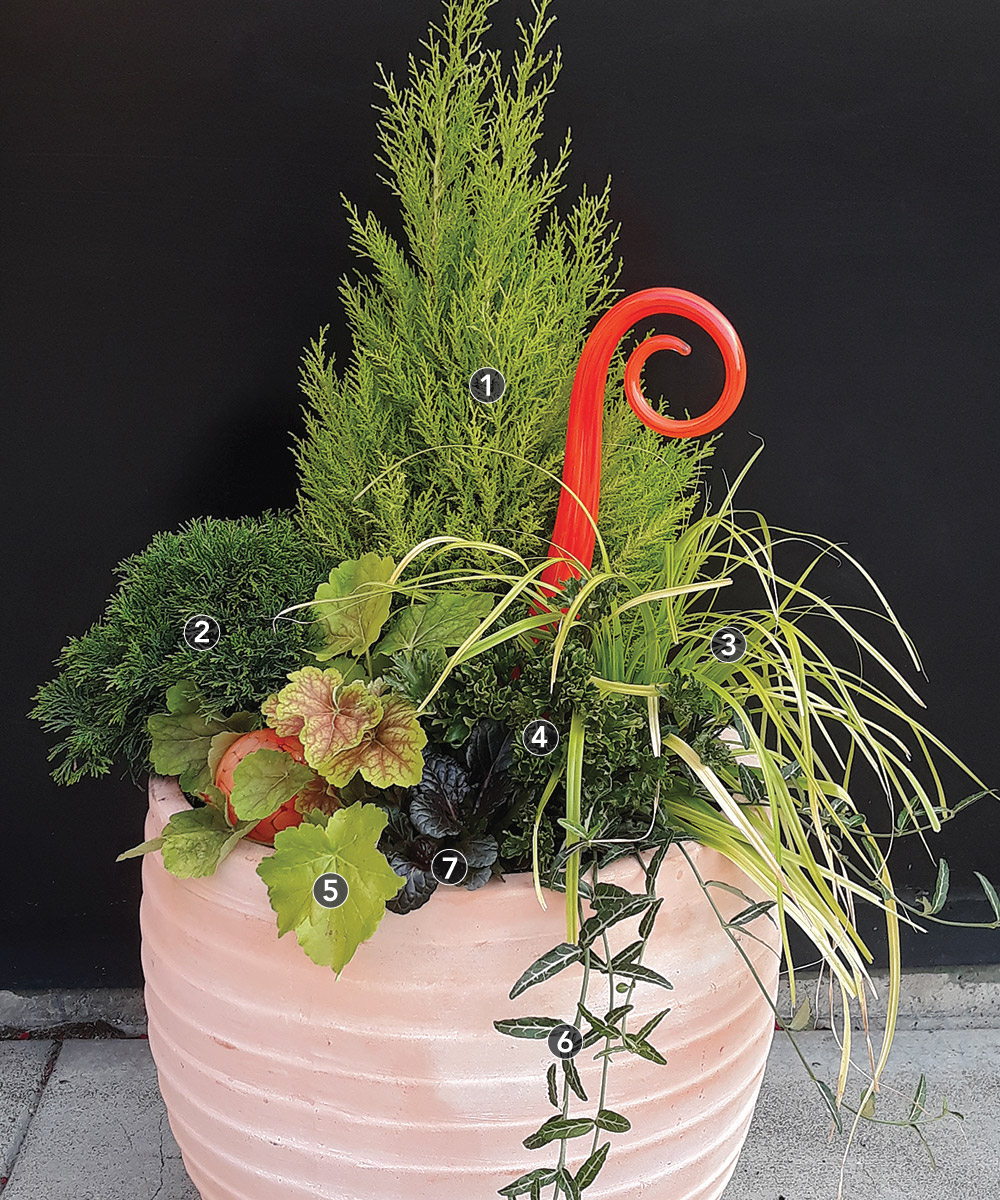Designing Long-Lasting Containers
Plants with multiple seasons of interest keep your pots looking fresh from spring through fall

We are all probably familiar with this scenario: You’ve created a beautiful container planting that brings you joy in spring, only to have that joy turn to dismay when the container needs constant refreshing throughout the remainder of the outdoor living season. Is it too much to expect that a plant combination that looks good in spring can last all summer and still perform into fall? It is absolutely possible to create beautiful container plantings that will perform for multiple seasons so that you can focus on enjoying, instead of maintaining, your outdoor oasis. It all starts with thoughtful plant choices for the style of planting you want. Let’s look at a few strategies for designs that go the distance.
Learn more: Six Ways to Improve Your Garden With Containers
Some annuals just seem to go on and on. Choosing your annuals wisely can gain you another month or two without having to replace plants. These annuals can give you a more tropical, seasonal vibe and are perfect for those who love bold color. Many annuals feature outstanding foliage, and some give the best of all worlds—amazing foliage plus abundant, colorful blooms. If you want to plant before the warm-season annuals are available, use spring pansies as colorful, inexpensive placeholders.
Strategy 1: Choose powerhouse annuals
Lasting tropical appeal
It’s easy to go tropical and still have a long-lasting container when you add a few perennial foliage plants to the mix. While some cannas have amazing, Technicolor-striped leaves, the simple green leaves here are set off by one of the many multipurpose euphorbia cultivars. The vincas provide a color echo and are additional extremely long bloomers, as is the ornamental oregano. The vinca and oregano will finally fade just as fall mums and pansies are coming into bloom, and a quick swap will keep the whole thing going until the first good freeze.
- Cannova® Red Shades canna lily (Canna × generalis ‘Cannova Red Shades’, Zones 7–11)
- ‘Ascot Rainbow’ euphorbia (Euphorbia × martinii ‘Ascot Rainbow’, Zones 6–9)
- Renegade cordyline (Cordyline ‘Tana’, Zones 8–11)
- ‘Black Forest Cake’ heuchera (Heuchera sanguinea ‘Black Forest Cake’, Zones 4–9)
- Titan™ Rose vinca (Catharanthus roseus ‘PAS336363’, Zones 10–11)
- ‘Kirigami’ ornamental oregano (Origanum ‘Kirigami’, Zones 6–9)
- ‘Goldilocks’ creeping Jenny (Lysimachia nummularia* ‘Goldilocks’, Zones 3–9)
- ‘Black Scallop’ ajuga (Ajuga reptans ‘Black Scallop’, Zones 3–9)
Plant paletteColor key: red, gold, purple Seasonal update: In fall, replace the vinca (5) with ‘Morgana Red’ garden mum (Chrysanthemum morifolium ‘Morgana Red’, Zones 7–9) and the ornamental oregano (6) with Delta™ Premium Persian Medley pansy (Viola × wittrockiana ‘Delta Persian Medley’, Zones 7–10). |
Bright blooms and sultry leaves
This planting shows the power of the fancy leaf geranium, which sets the palette for the entire combination. The chocolate color in the leaves is echoed by the purple fountain grass, a tender perennial that looks amazing all summer and ushers in fall with tall, glorious plumes. Dark ajuga grounds the combination, while the variegated bergenia seedheads are a surprising color echo as well. In the mild Pacific Northwest, this geranium blooms profusely even through the first chilly weeks of October. Now that is a powerhouse annual!
- Purple fountain grass (Pennisetum setaceum* ‘Rubrum’, Zones 9–10)
- ‘Tubby Andrews’ bergenia (Bergenia cordifolia ‘Tubby Andrews’, Zones 3–8)
- Tree aeonium (Aeonium arboreum, Zones 9–11)
- ‘Brocade Fire’ geranium (Pelargonium ‘Brocade Fire’, Zones 10–11)
- Sweet Caroline Bewitched Green With Envy™ sweet potato vine (Ipomoea batatas ‘NCORNSP-020BWGWE’, Zones 10–11)
- ‘Black Scallop’ ajuga (Ajuga reptans ‘Black Scallop’, Zones 3–9)
Plant paletteColor key: rust, lime, red, black Seasonal update: In autumn, tuck in an ornamental pepper or a red-tinted viola (Viola cv., Zones 3–9) to replace the sweet potato vine (5). |
Strategy 2: Build around an evergreen scaffold
By creating an evergreen or permanent deciduous structure, you can change up your annuals more often for those who like more variety. Think of your annuals as jewelry, ready for easy replacement when things get tough, or when you discover a new annual that you absolutely must try. Since most annuals have a relatively small root system, it’s easy to remove them without disturbing the larger, more permanent plants.
Warmth with a little sparkle
The main structure here is made up of plants that will last many seasons together. The tree retains its deep purple color well into fall and provides interesting branch structure for winter. Three long-blooming annuals add an extra pop of color for the warmer season. With this type of planting there are so many options for annuals, and you can change types each year for extra variety.
- Sunset Magic™ crape myrtle (Lagerstroemia ‘PIILAG-IX’, Zones 6–9)
- Spreading English yew (Taxus baccata ‘Repandens’, Zones 5–9)
- ‘Tricolor’ hebe (Hebe speciosa ‘Tricolor’, Zones 8–10)
- Forever® Red heuchera (Heuchera ‘TNHEUFR’, Zones 4–9)
- Angelface® White summer snapdragon (Angelonia angustifolia ‘Anwhitim’, Zones 10–11)
- Lascar™ Black Velvet verbena (Verbena ‘KLEVP15618’, Zones 10–11)
- ‘Silver Falls’ dichondra (Dichondra argentea ‘Silver Falls’, Zones 8–10)
Plant paletteColor key: purple, white, red Seasonal update: In spring, start off with ‘Penny Peach Jump Up’ viola (Viola ‘Penny Peach Jump Up’, Zones 4–8) in place of the verbena (6), and a white narcissus in place of the snapdragon (5). |
A fresh mix of fun foliage
Three evergreen plants anchor this combination: burgundy New Zealand flax, variegated white euphorbia, and cushion bush. The perennial yarrow is a long bloomer, and the faded blooms are retained and add interest even when turning tawny. The addition of three stellar annuals makes this a long-lived combination, especially as it relies on only one blooming plant for color. In late summer, replacing the zinnia with an upright sedum will push the combo further into fall.
- ‘Sundowner’ New Zealand flax (Phormium ‘Sundowner’, Zones 8–11)
- Silver Swan euphorbia (Euphorbia characias ‘Wilcott’, Zones 7–10)
- ‘Double Profusion Hot Cherry’ zinnia (Zinnia ‘Double Profusion Hot Cherry’, annual)
- ‘Sassy Summer Sangria’ yarrow (Achillea millefolium ‘Sassy Summer Sangria’, Zones 3–8)
- ‘Great Falls Iguazu’ coleus (Plectranthus scutellarioides ‘Great Falls Iguazu’, Zones 10–11)
- ‘Silver Stone’ cushion bush (Calocephalus brownii ‘Silver Stone’, Zones 9–11)
- Irish moss (Sagina subulata, Zones 4–8)
- SolarPower™ Red Heart sweet potato vine (Ipomoea batatas ‘Balsolaredar’, Zones 10–11)
Plant paletteColor key: magenta, wine, silver, white Seasonal update: In fall, replace the zinnia (3) and the yarrow (4) with ‘Neon’ sedum (Hylotelephium spectabile ‘Neon’, Zones 3–9), and the coleus (5) and the sweet potato vine (8) with ornamental cabbage. |
Strategy 3: Go all in on foliage
This is the simplest way to get three or four seasons of performance out of your plant combinations. Combining primarily evergreen plants may not feature bushels of blooms, but that doesn’t mean they have to be boring. Choosing a mix of conifers and broadleaf evergreens with an eye toward contrasting foliage color, texture, and form can give spectacular results, and such a combination has a certain soothing quality that is perfect for those who want as little maintenance as possible.
Crisply contrasting colors
This is another example of the variety that you can get when you pay special attention to foliage. Picking up the color of the pot is an easy first step toward color harmony; the white-veined sedge and the gray of the cushion bush echo the pot and provide liveliness amid the darker foliage. The key is to surround each plant with foliage of different colors to keep the eye moving around the design as a whole. Only the sedum is deciduous, and the other plants will readily fill that hole when the time comes. Topping the soil with a coordinating pebble mulch adds a little extra sophistication.
- ‘Sundance’ Mexican orange blossom (Choisya ternata ‘Sundance’, Zones 7–10)
- Cushion bush (Calocephalus brownii, Zones 9–11)
- ‘Sunset Boulevard’ hebe (Hebe ‘Sunset Boulevard’, Zones 8–10)
- ‘Frosted Fire’ sedum (Hylotelephium ‘Frosted Fire’, Zones 4–8)
- ‘Diamond Heights’ Carmel creeper (Ceanothus griseus var. horizontalis ‘Diamond Heights’, Zones 8–10)
- Everest sedge (Carex oshimensis ‘Carfit01’, Zones 5–9)
- ‘Black Scallop’ ajuga (Ajuga reptans ‘Black Scallop’, Zones 3–9)
Plant paletteColor key: yellow, gray, lime, black Seasonal update: For four seasons of color, replace the sedum (4) with an evergreen such as ‘Shimmer’ heuchera (Heuchera ‘TNHEUSHI’, Zones 4–9). |
Fine lines and frilly textures
With multiple shades of green and different textures, this container shows how interesting foliage can be. Note the range of leaf colors: lime, emerald, gold, and nearly black. Pay special attention to stem colors or veining, as with the heuchera at center stage with its bright orange veining, and the delicate white veining on the wintercreeper. In this group, only the parsley leopard plant will die back; a light covering of cut winter boughs tucked into the soil around the crown is a great way to fill the space until its glorious return in spring.
- ‘Wilma Goldcrest’ Monterey cypress (Cupressus macrocarpa ‘Wilma Goldcrest’, Zones 7–10)
- ‘Green Globe’ Lawson cypress (Chamaecyparis lawsoniana ‘Green Globe’, Zones 5–9)
- ‘Everillo’ sedge (Carex oshimensis ‘Everillo’, Zones 5–9)
- ‘Shishi Botan’ parsley leopard plant (Farfugium japonicum ‘Shishi Botan’, Zones 7–10)
- ‘Delta Dawn’ heuchera (Heuchera ‘Delta Dawn’, Zones 4–9)
- ‘Wolong Ghost’ silver-veined wintercreeper (Euonymus fortunei* ‘Wolong Ghost’, Zones 4–9)
- ‘Black Scallop’ ajuga (Ajuga reptans ‘Black Scallop’, Zones 3–9)
Plant paletteColor key: black, gold, lime, orange Seasonal update: In winter, tuck in some evergreen boughs to cover the crown of the parsley leopard plant (4). |
*Invasive alerts:
Creeping Jenny (Lysimachia nummularia)
This plant is considered invasive in AK, CT, IL, KY, MA, NH, OR, PA, RI, TN, VA, WI, and WV.
Purple fountain grass (Pennisetum setaceum)
This plant is considered invasive in AZ, CA, and NM.
Wintercreeper (Euonymus fortunei)
This plant is considered invasive in AL, IL, IN, KY, MD, MO, NC, NH, NJ, NY, TN, VA, WI, and WV.
Please visit invasiveplantatlas.org for more information.
Barbara Libner is the head container designer and chief merchandiser at Ravenna Gardens in Seattle.
Photos by Barbara Libner.
From Fine Gardening #205












Comments
Log in or create an account to post a comment.
Sign up Log in